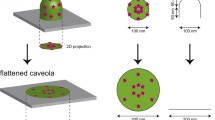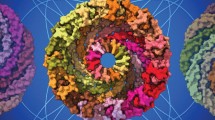Abstract
Caveolae were defined as flask- or omega-shaped plasma membrane invaginations, abundant in adipocytes, fibroblasts, endothelial and smooth muscle cells. The major protein component of caveolar membranes is an integral membrane protein named caveolin. We compared the freeze-fracture behavior of caveolae in glutaraldehyde-fixed and cryofixed mouse fibroblast cells and found distinct differences. In glutaraldehyde-fixed cells almost all caveolae were cross-fractured through their pore and only very few caveolar membranes were membrane-fractured. We found the reverse situation in rapid frozen cells without any chemical fixation where most of the caveolae were membrane-fractured, showing different degrees of invagination from nearly flat to deeply invaginated. In ultrathin sections of glutaraldehyde-fixed heart endothelial cells, caveolae exhibit the well known omega-like shape. In high-pressure frozen, freeze-substituted and low temperature embedded heart endothelial cells, the caveolae frequently exhibit a cup-like shape without any constriction or pore. The cup-like caveolar shape could also be shown by tilt series analysis of freeze-fracture replicas obtained from cryofixed cells. Freeze-fracture immunolabeling of caveolin-1 revealed a lateral belt-like caveolin alignment. These findings point out that the constricted “neck” region of caveolae in most cases is an effect that is caused and intensified by the glutaraldehyde fixation. Our data indicate that caveolae in vivo show all degrees of invagination from nearly flat via cup-like depressed to in a few cases omega-like.




Similar content being viewed by others
References
Antal M, Fukazawa Y, Eördögh M, Muszil D, Molnár E, Itakura M, Takahashi M, Shigemoto R (2008) Numbers, densities, and colocalization of AMPA- and NMDA-type glutamate receptors at individual synapses in the superficial spinal dorsal horn of rats. J Neurosci 28(39):9692–9701
Benlimame N, Le PU, Nabi IR (1998) Localization of autocrine motility factor receptor to caveolae and clathrin-independent internalization of its ligand to smooth endoplasmic reticulum. Mol Biol Cell 9:1773–1786
Cohen AW, Hnasko R, Schubert W, Lisanti MP (2004) Role of caveolae and caveolins in health and disease. Physiol Rev 84:1341–1379
Collins VP, Arborgh B, Brunk U (1977) A comparison of the effects of three widely used glutaraldehyde fixatives on cellular volume and structure. A TEM, SEM, volumetric and cytochemical study. Acta Pathol Microbiol Immunol Scand Sect A Pathol 85A:157–168
Couet J, Li S, Okamoto T, Scherer PS, Lisanti MP (1997) Molecular and cellular biology of caveolae: paradoxes and plasticities. Trends Cardiovasc Med 7:103–110
Ebersold HR, Cordier JL, Lüthy P (1981) Bacterial mesosomes: method dependent artifacts. Arch Microbiol 130:19–22
Foti M, Porcheron G, Fournier M, Maeder C, Carpentier JL (2007) The neck of caveolae is a distinct plasma membrane subdomain that concentrates insulin receptors in 3T3-L1 adipocytes. Proc Natl Acad Sci USA 104:1242–1247
Fujimoto K (1995) Freeze-fracture replica electron microscopy combined with SDS digestion for cytochemical labeling of integral membrane proteins. Application to the immunogold labeling of intercellular junctional complexes. J Cell Sci 108:3443–3449
Fujimoto K (1997) SDS-digested freeze-fracture replica labelling electron microscopy to study the two-dimensional distribution of integral membrane proteins and phospholipids in biomembranes: practical procedure, interpretation and application. Histochem Cell Biol 107:87–96
Fujimoto T, Fujimoto K (1997) Metal sandwich method to quick-freeze monolayer cultured cells for freeze-fracture. J Histochem Cytochem 45:595–598
Fujimoto T, Kogo H, Nomura R, Une T (2000) Isoforms of caveolin-1 and caveolar structure. J Cell Sci 113:3509–3517
Hommelgaard AM, Roepstorff K, Vilhardt F, Torgersen ML, Sandvig K, van Deurs B (2005) Caveolae: stable membrane domains with a potential for internalization. Traffic 6:720–724
Johnson TJA (1985) Aldehyde fixatives: quantification of acidproducing reactions. J Electron Microsc Techn 2:129–138
Jost P, Brooks UJ, Griffith OH (1973) Fluidity of phospholipid bilayers and membranes after exposure to osmium tetroxide and gluteraldehyde. J Mol Biol 76:313–318
Kirschning E, Rutter G, Hohenberg H (1988) High-pressure freezing and freeze-substitution of native rat brain: suitability for preservation and immunoelectron microscopic localization of myelin glycolipids. J Neurosci Res 53:465–474
Lee RM, McKenzie R, Kobayashi K, Garfield RE, Forrest JB, Daniel EE (1982) Effects of glutaraldehyde fixative osmolarities onsmooth muscle cell volume, and osmotic reactivity of the cells after fixation. J Microsc 125:77–88
McGuire PG, Twietmeyer TA (1983) Morphology of rapidly frozen aortic endothelial cells. Glutaraldehyde fixation increases the number of caveolae. Circ Res 53:424–429
Palade GE (1953) Fine structure of blood capillaries. J Appl Phys 24:1424
Parton RG, Joggerst B, Simons K (1994) Regulated internalization of caveolae. J Cell Biol 127:1199–1215
Richter T, Floetenmeyer M, Ferguson C, Galea J, Goh J, Lindsay MR, Morgan GP, Marsh BJ, Parton RG (2008) High-resolution 3D quantitative analysis of caveolar ultrastructure and caveola-cytoskeleton interactions. Traffic 9:893–909
Robinson JM, Hoover RL, Karnovsky MJ (1984) Vesicle (caveolae) number is reduced in cultured endothelial cells prepared for electron microscopy by rapid-freezing. J Cell Biol 99:287a
Rothberg KG, Heuser JE, Donzell WC, Ying Y-S, Glenney JR, Anderson RGW (1992) Caveolin, a protein component of caveolae membrane coats. Cell 68:673–682
Schloermann W, John M, Steiniger F, Westermann M, Richter W (2007) Improved antigen retrieval in freeze-fracture cytochemistry by evaporation of carbon as first replication layer. Histochem Cell Biol 127:633–639
Severs NJ (1988) Caveolae: static inpocketings of the plasma membrane, dynamic vesicles or plain artifact? J Cell Sci 90:341–348
Simons K, Toomre D (2000) Lipid rafts and signal transduction. Nat Rev Mol Cell Biol 1:31–39
Stan RV (2002) Structure and function of endothelial caveolae. Microsc Res Tech 57:350–364
Szczesny PJ, Walther P, Müller M (1996) Light damage in rod outer segments: the effects of fixation on ultrastructural alterations. Curr Eye Res 15:807–814
Thomas CM, Smart EJ (2008) Caveolae structure and function. J Cell Mol Med 12:796–809
Westermann M, Steiniger F, Richter W (2005) Belt-like localisation of caveolin in deep caveolae and its re-distribution after cholesterol depletion. Histochem Cell Biol 123:613–620
Yamada E (1955) The fine structure of the gall bladder epithelium of the mouse. J Biophys Biochem Cytol 1:445–458
Yao Q, Chen J, Cao H, Orth JD, McCaffery JM, Stan RV, McNiven MA (2005) Caveolin-1 interacts directly with dynamin-2. J Mol Biol 348:491–501
Author information
Authors and Affiliations
Corresponding author
Rights and permissions
About this article
Cite this article
Schlörmann, W., Steiniger, F., Richter, W. et al. The shape of caveolae is omega-like after glutaraldehyde fixation and cup-like after cryofixation. Histochem Cell Biol 133, 223–228 (2010). https://doi.org/10.1007/s00418-009-0651-8
Accepted:
Published:
Issue Date:
DOI: https://doi.org/10.1007/s00418-009-0651-8




